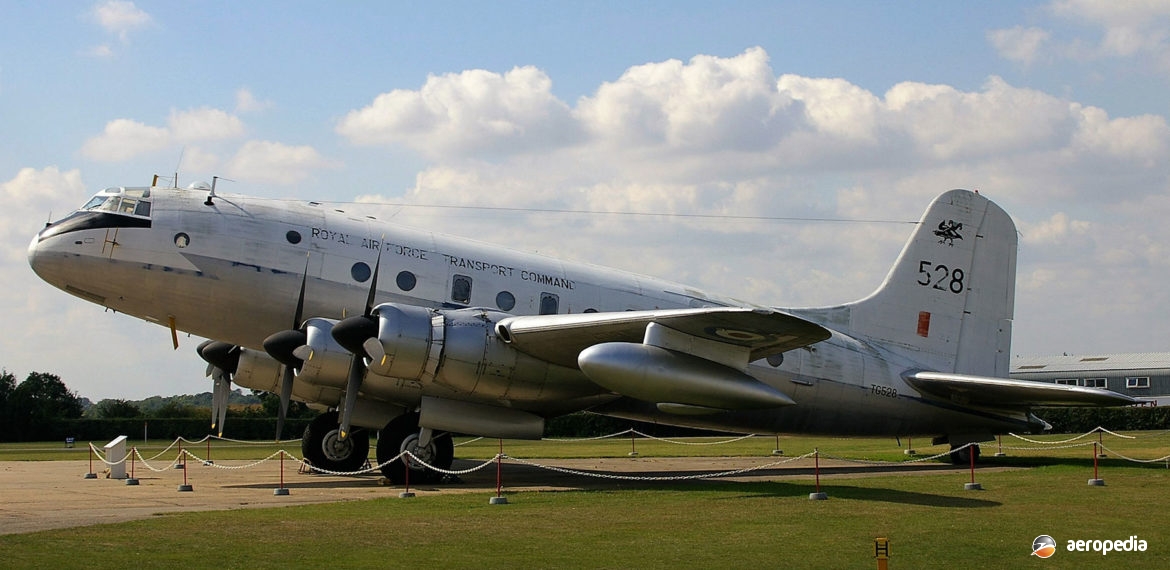Photograph:
RAF Transport Command Handley Page Hastings C.1 TG528 at Duxford, Cambridgeshire in the United Kingdom (David C Eyre)
Country of origin:
United Kingdom
Description:
Long-range military transport
Power Plant:
Four 1,250 kw (1,675 hp) Bristol Hercules 106 eighteen-cylinder sleeve-valve air-cooled radial engines
Specifications:
- Wingspan: 34.42 m (113 ft)
- Length: 25.19 m (82 ft 8 in)
- Height: 6.85 m (22 ft 6 in)
- Wing area: 130.8 m² (1,408 sq ft)
- Max speed at 6,706 m (22,000 ft): 560 km/h (348 mph)
- Cruising speed: 486 km/h (302 mph)
- Initial rate of climb: 271 m/min (890 ft/min)
- Time to 6,096 m (20,000 ft): 26 minutes
- Service ceiling: 8,077 m (26,500 ft)
- Range (normal): 2,719 km (1,690 miles)
- Max range: 6,838 km (4,250 miles)
- Empty weight: 21,966 kg (48,427 lb)
- Loaded weight: 36,200 kg (80,000 lb)
History:
The Handley Page Hastings was designed as a replacement for the Avro York transport in Royal Air Force (RAF) service, and the prototype (TE580) made its first flight at Wittering in Cambridgshire on 7 May 1946, the second prototype (TE583) being flown for the first time on 30 December that year. The first production batch for the RAF was known as the Hastings C.1, and this was followed by the C.2 which differed from the C.1 in having a lower-set tailplane of increased area, spring tabs fitted to the elevators, and extra fuel tanks in the outer wings, the first C.2 flying on 14 November 1950. Forty C.2s were built and subsequently the C.1s were modified to C.2 standard, then becoming known as the C.1A.
The type was used by a number of RAF Squadrons, including No 202 Meteorological Reconnaissance Squadron, and saw considerable service during the Berlin Airlift (‘Operation Plainfare’). The first RAF squadron of Transport Command to be equipped was No 47 at Dishforth in North Yorkshire in October 1948. The type was operated by a crew of five and could accommodate 30 equipped paratroops with supplies, 42 stretchers plus 28 sitting casualties, or 50 fully equipped troops, or freight. A total of 147 was built for the RAF, including two prototypes, comprising 100 C.1, 43 C.2 and four C.3 transports for the Royal New Zealand Air Force (RNZAF).
The type was a regular visitor to this region. First example seen in Australia was a C.1 (TG503) which made a tour of Australasia, leaving RAF Lyneham in North Wiltshire on 11 March 1948 and arriving in Sydney, NSW a week later, a total of 46½ hours flying time, with a crew of Handley Page and RAF personnel on board, members of the Aeroplane & Armament Establishment (A&AE) at Boscombe Down in Wiltshire, Bristol staff and observers. At Singapore it picked up some Qantas flight crew as Qantas had at the time shown some interest in operating a civil variant. After a demonstration tour it returned to the United Kingdom, arriving back on 5 June 1948, having covered some 56,325 km (35,000 miles) in 160 flying hours.
Four examples of the Hastings, known as the C.3 (serials NZ5801 to NZ5804) were obtained for, and used by, No 41 Squadron RNZAF from 1952, being powered by the Bristol Hercules 737 engine providing 1,522 kw (2,040 hp), this giving an improved performance over the aircraft supplied to the RAF. The first aircraft NZ5801 (c/n 127) was first flown on 3 November 1951, being handed over to the New Zealand Prime Minister on 30 January 1952. The other three NZ5802 (c/n 128), NZ5803 (c/n 129), and NZ5804 (c/n 150) followed later. One NZ5803 was entered in the 1953 London to Christchurch (NZ) air race but had to withdraw in Ceylon due to water damage sustained on a flooded field.
In 1953 the Squadron was re-numbered No 40 Squadron. In 1952 the Hastings saw service flying NZ troops and supplies to Japan during the Korean conflict. The Hastings was eventually replaced by the Lockheed C-130K Hercules in 1966, having flown 11,435,685 km (7,106,000 miles) in 29,003 flying hours. Many flights were made to Australia, Singapore, Japan and Washington in the United States, as well as many of the Pacific Islands.
One Hastings was lost in New Zealand service. NZ5804 (c/n 150) suffered an engine failure on take-off at Darwin, NT in 1955 and the pilot put the aircraft back on to the runway at 241 km/h (150 mph), left the runway, ran across a ditch and a road, over the top of a hill, and across a water-main, ending up on a railway line. It was extensively damaged and written off as beyond repair.
After withdrawal from service the RNZAF Hastings were scrapped. All that survived was the forward fuselage of NZ5801 at the Ministry of Transport and Technology (MOTAT) Museum in Auckland.

